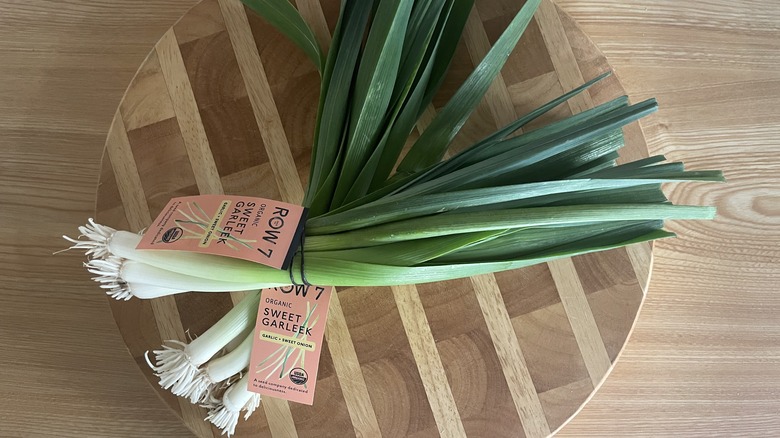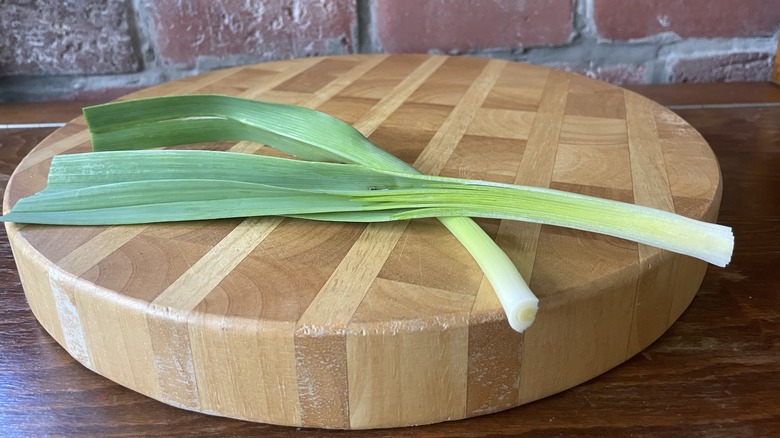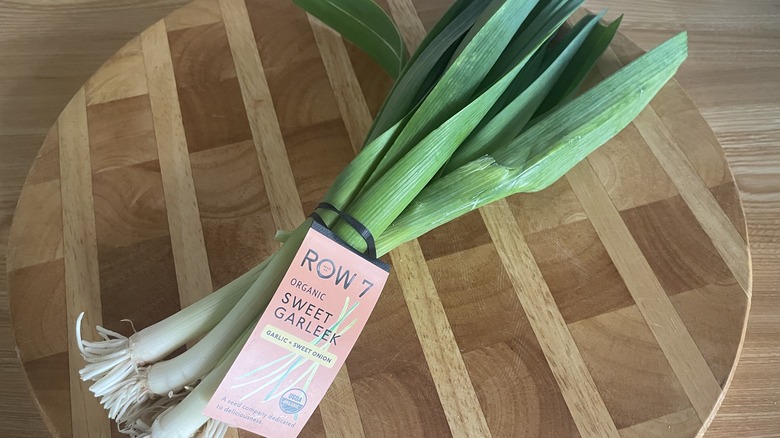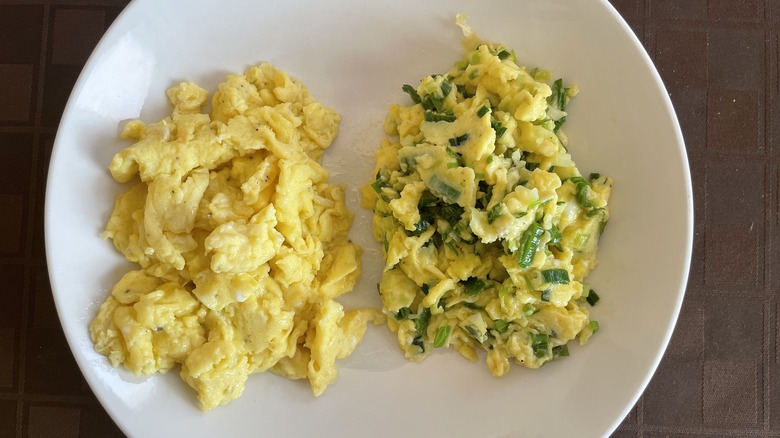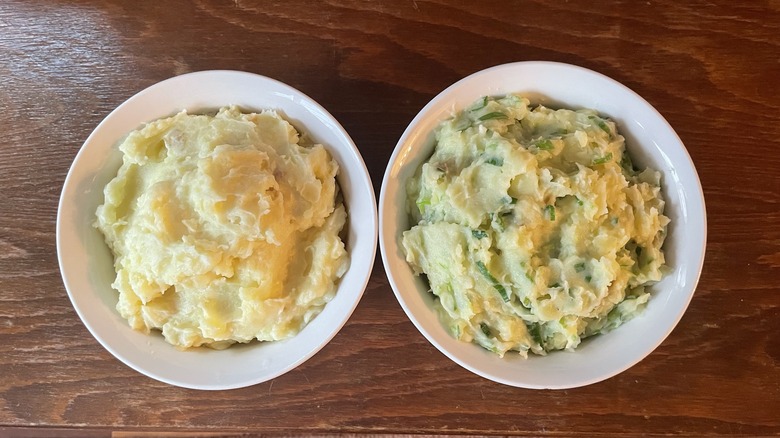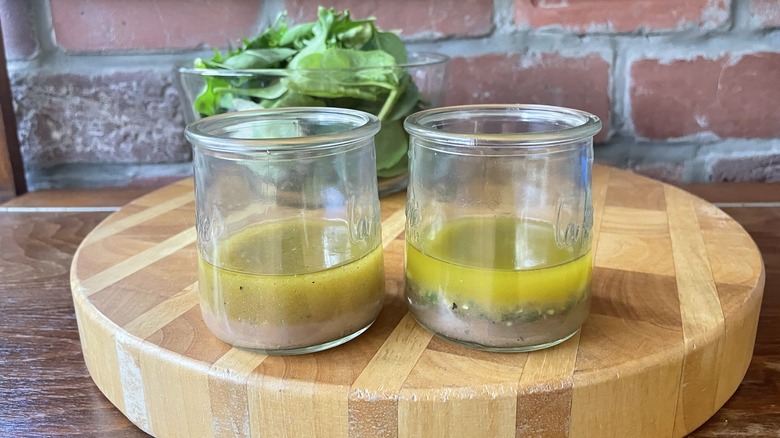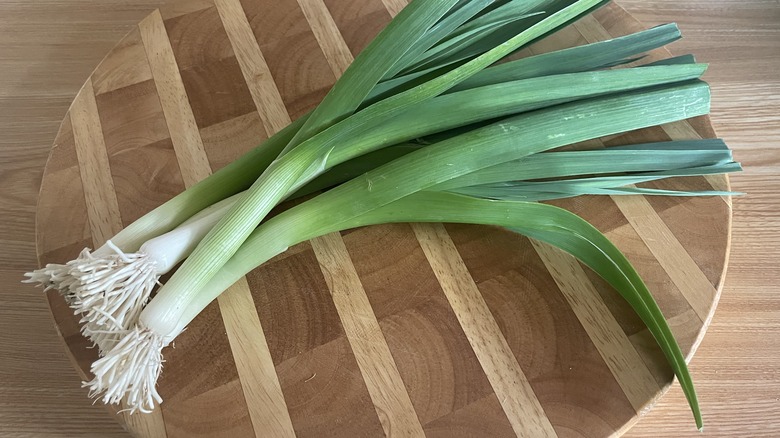Review: Hybrid Vegetable Sweet Garleek Is A Welcome New Ingredient, But Not Quite A Garlic Substitute
The produce section of a supermarket can be one of the most exciting places to shop. In addition to everyday essentials like lemons, berries, potatoes, and salad greens, there is often something new and delicious to be found, from pink pineapple to baby cucumbers to Moon Drop grapes. Sometimes a new ingredient can spark inspiration in the kitchen to create something new or offer an easy way to put a spin on a favorite recipe.
If alliums are your thing (think onions, leeks, garlic, and scallions), then you should take note of a new seasonal entry to the market: Sweet Garleek. To try it out, we picked three classic recipes that often feature garlic: scrambled eggs, mashed potatoes, and a vinaigrette. We made two versions of each recipe, adding conventional garlic to one batch and Sweet Garleek to the other to compare the differences between the alliums in everything from the visual distinctions to the overall flavor changes.
What is Sweet Garleek?
Sweet Garleek is one of the newer items brought to market by the Row 7 Seed Company. Co-founded by the chef and co-owner of Blue Hill and Blue Hills Stone Barns, Dan Barber, the company works to better the fruits and veggies you eat. From beets and potatoes to squash and tomatoes, each vegetable is crafted over time through cross-pollination to make something new and more delicious than other current varieties.
Sweet Garleek has been developed over the last decade as a new allium that offers some of the punch of garlic while maintaining the sweetness and grassy green flavor of leeks. Lengthwise, it is comparable to a long scallion, but the green tops are flat, broad, and darker green than the bright, round hollow tubes on a scallion. Halved lengthwise, you can see the circular layers of Sweet Garleek, similar to a leek, which need to be washed well as dirt and grit can easily get trapped. The entire stalk of Sweet Garleek is edible and can be eaten raw or cooked in multiple ways, from roasting to sautéing.
How much does it cost and where is it available?
Sweet Garleek is priced at around $5.99 per bunch, depending on where you get it from. While this is a higher price point than a bunch of leeks, scallions, or garlic (around $4.99 per bunch, under $2.00 per bunch, and under $1 per head), there are a few factors that go into the higher price tag including availability and seasonality.
Sweet Garleek is only available at select Whole Foods Market stores. Although it is grown at farms in New York, New Jersey, and Massachusetts, it is currently only distributed in the New York City area during its growing season from September through October. This year was a test market release for Sweet Garleek Row 7 President Charlotte Douglas explains, "Next year, we plan to expand to sell Garleek throughout the Northeast, West Coast, and mid-Atlantic, and then nationally in 2025, as we expand our regional organic growing model." Additionally, as Row 7 is also in the business of selling seeds, the seeds for Sweet Garleek will be available soon for purchase from the website for those who want to grow it themselves.
Taste test: Using Sweet Garleek in scrambled eggs
Scrambled eggs are a fast and easy go-to breakfast. Adding some fresh garlic or herbs is a quick way to take them to a new level. For this taste test, large eggs were whipped with a splash of milk, salt, and pepper until very well combined. In one pan, thinly sliced garlic was cooked in butter over medium-low heat until softened but not browned, and then the same was done in a second pan using one whole Sweet Garleek, thinly sliced. The eggs were gently scrambled in each pan until just set.
The garlic-studded eggs did not look much different from plain scrambled eggs, but the aroma and flavor were quite strong. The gentle cook on the garlic, paired with the richness of butter, softened the sharp and spicy edge inherent to raw garlic and brought out some of its sweeter notes but did not fully tame it. Through and through, these eggs were infused with garlic permeating each bite.
The eggs with Sweet Garleek visually popped as the dark green contrasted with the yellow eggs. The overall flavor was more complex than the garlic counterpart. Cooking Sweet Garleek in butter enhanced the flavors of the allium. The dark green ends had a green vegetal taste similar to green pepper mixed with spring onions and retained some texture with a gentle crunch. The white root end added a subtle garlic flavor that was pronounced yet not overwhelming to the mild eggs.
Taste test: Using Sweet Garleek in mashed potatoes
Adding leeks or garlic to mashed potatoes is a delicious tried and true combination, so it was a perfect vehicle to compare the flavors of garlic and Sweet Garleek. The base of these mashed potatoes were unpeeled Yukon Gold potatoes, chunked up and boiled in well-salted water until tender. Warmed whole milk, melted butter, and salt were added to each batch. One batch received minced garlic while the other a whole chopped piece of Sweet Garleek before getting mashed well. The warmth of the potatoes, milk, and butter gave a light cook to each allium.
The garlic mashed potatoes brought an immediate and sharp hit of garlic to the potatoes that cut through the dairy and perfumed the whole batch. While the garlic did not leave a lingering taste or fiery breath, it was more pronounced than in the scrambled eggs and defined these as garlic mashed potatoes and not mashed potatoes with garlic.
The Sweet Garleek mashed potatoes were visually striking and peppered with lots of gently squeaky green tops that made them look like Irish colcannon. Similar to the scrambled eggs, Sweet Garleek brought a range of flavors to the potatoes. As there is a lot more of the oniony greens than the garlicky whites to each piece of Sweet Garleek, the potatoes ended up skewing more oniony with a back hint of garlic.
Taste test: Using Sweet Garleek in a vinaigrette
The third recipe to compare garlic to Sweet Garleek was a classic vinaigrette. To make the vinaigrette, we whisked red wine vinegar with a spoonful of mustard until smooth and then streamed in olive oil. Each vinaigrette was seasoned with salt, pepper, and a pinch of sugar. One batch had one clove of raw minced garlic, and the other batch had 1 tablespoon raw minced Sweet Garleek, using a mixture of the white and green parts. Each had the same ratios of vinegar, mustard, and oil.
Visually, there was little difference between the two vinaigrettes but a big difference in flavor. The vinaigrette with minced garlic had a sharp, savory flavor that laced the entire vinaigrette regardless of eating a bite with an actual garlic piece. The vinaigrette had a familiar and recognizable taste that would stand up well to an assortment of salad greens and ingredients from cheeses to meats to olives.
The version with the Sweet Garleek was a little surprising. The vinaigrette had a background savory flavor, but it was hard to identify the source of the flavor. Even bites of lettuce with a good amount of Sweet Garleek bits just tasted like a well-seasoned vinaigrette. Raw Sweet Garleek did not cut through the vinegar and oil as easily as the garlic. However, the vinaigrette still had a balanced taste, and the lack of super strong garlicky notes would make this a more versatile vinaigrette choice.
The overall verdict
Sweet Garleek is an excellent addition to the available alliums at the supermarket. Its versatility in cooking methods, the fact that the whole vegetable is edible, and the unique multi-faceted flavor profile means there is little opportunity to have it go unused and slowly mulch in the refrigerator.
Is it a replacement for garlic? No. Is it a replacement for a leek? Well, no. In each taste test, we had two pretty different versions of the same thing, but the versions were like siblings ― they were a little the same while also being unique.
Rather than treating Sweet Garleek as a straight substitution, it is helpful to think of it as a multi-purpose allium that brings a little bit of onion, garlic, and leek together into one. You can easily swap it into a recipe that calls for garlic, leek, or scallion, knowing it will change the finished results some, but perhaps pleasantly so.
